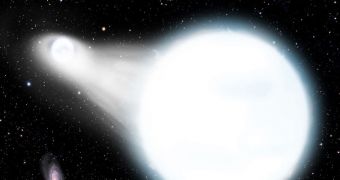Astronomers with the Harvard-Smithsonian Center for Astrophysics (CfA) announce the discovery of a pair of white dwarf stars locked in a binary system. The two objects are moving closer and closer to each other, and are expected to merge together in the future.
White dwarfs are the remnants of Sun-like stars. They are produced when a star swells into a red giant, and then sheds the outer layers of its atmosphere. All that is left afterwards is the former object's core, which burns helium instead of hydrogen.
Our Sun will also turn into such an object, after its red giant phase will see it extending beyond the orbit of Earth. This will happen in about 5 billion years, after the star exhausts its hydrogen reserves.
The white dwarfs in the newly-found system are well beyond this phase. Over millions of years of interactions, they drew closer and closer together. At this point, the objects carry out a full orbit around each other in just 13 minutes.
Gradually, this time will be reduced until the stars will merge together. This may lead to a massive supernova blast, astronomers say, although there is no way to know for sure whether this will happen.
Early calculations estimate that it will take about 900,000 years for the stars to collide with each other. This is the blink of an eye in astronomical terms. As the process unfolds, experts will monitor the system, using it to test Albert Einstein's Theory of General Relativity.
Continuous observations will also help investigators gain more insight into the origin of some peculiar supernovae. However, experts may have to wait a while for that to happen, the CfA team explains.
The stars are moving around each other at a speed 180 times faster than the fastest jet on Earth, or roughly 370 miles (600 kilometers) per second. This discovery left astronomers puzzled, and scrambling to find an explanation for the amazing speed.
“I nearly fell out of my chair at the telescope when I saw one star change its speed by a staggering 750 miles per second in just a few minutes,” explains the lead author of the new research effort, CfA astronomer Warren Brown.
The brightest of the two objects was found to weigh about a quarter solar mass. All this material is packed tightly in a sphere the size of Neptune. The accompanying white dwarf tips the scales at half the Sun's mass, and is only as large as Earth.
“If there were aliens living on a planet around this star system, they would see one of their two suns disappear every 6 minutes – a fantastic light show.” CfA astronomer and study coauthor Mukremin Kilic explains.
Details of the new investigation have been accepted for publication in an upcoming issue of the esteemed Astrophysical Journal Letters.

 14 DAY TRIAL //
14 DAY TRIAL //